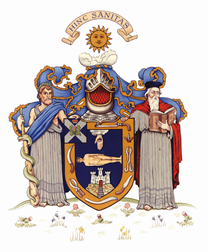FRRHH Unveils New Logo
« View all FRRHH News items
As one of the oldest surgical Colleges in the world, the founding of The Royal College of Surgeons of Edinburgh (RCSEd) in 1505 is hugely significant in the history of surgical developments. In present day, the College has grown to serve almost 30,000 Affiliates, Members, and Fellows across the globe with 40% of membership based overseas. Launched in August 2020, the new RCSEd brand identity was created to reflect this history, reach and growth and echoes them down to all faculties (including FRRHH) that sit alongside the main College.
In developing the new logo for the College and subsequent faculties, it was important to show the pride of our origins in Edinburgh but also dedication to our friends and members across the globe.
The College Sigillum - which will continue to be an important part of the College fabric - provided symbolic elements from the crest that were incorporated into the new logo.
- The ‘sun’ which depicts clarity over ignorance;
- The ‘castle’ which signifies physical roots in Edinburgh – a city known for innovation and education in medicine and surgery;
- The year of foundation ‘1505’ which marks the date of receiving Royal charter.

Presenting itself as a symbol that would bind these elements, the Unicorn was an obvious choice as the favourite heraldic animal of James IV, the king who gave the College its Royal Charter in 1505. The Unicorn is also a heraldic symbol of Scotland and is known as the ‘Horse of Healing’. It is seen as a force for good in both Western and Eastern mythology with aspirational qualities including purity, boldness, pride, joy, intelligence, hope, and positivity. Such qualities overarch not just the College activities but the values and mission of each of the faculties that sit alongside The Royal College of Surgeons of Edinburgh.
Formally launched in November 2018, The Faculty of Remote and Rural Healthcare incorporated Humanitarian in its structure in August 2020 thus becoming The Faculty of Remote, Rural and Humanitarian Healthcare (FRRHH). The faculty was established in response to the need identified within both industry and the public health arena to define, review and set standards of competence for organisations as well as medical and non-medical personnel delivering healthcare in remote and rural environments.
With a primary objective to “improve the health outcomes of individuals living and working in remote, rural, austere and life-threatening areas of the world”, the strong identity created through the new College logo allows the faculty to act on and deliver activities to reflect this overarching vision.
On collaboration with the branding project, FRRHH Faculty Development Manager, Gill Mitchell was keen that the vision for FRRHH shone through when assigning the faculty specific colour identity to the FRRHH specific logo. Gill knew it was vital for the logo entirety to reflect the aim to ‘establish, promote and develop a diverse global community of healthcare professionals operating across various sectors, diverse industries and challenging settings.’ The values taken from the main college logo tied with the representation from the faculty specific colour ‘red’ in its signification of courage, action, survival and passion will incorporate and demonstrate FRRHH fittingly. The new logo will support the faculty activities as it develops leadership, innovation, standard setting in education and training in the fast-developing field of remote, rural and humanitarian healthcare.

Chair of The Faculty of Remote, Rural & Humanitarian Healthcare, Dr Rikard Moen shared in the exciting development of the visual identity of FRRHH commenting that:
'the Faculty are delighted to unveil this new logo, created to strengthen our mission statement of improving the health outcomes of individuals living and working in remote, rural, austere and life threatening areas of the world. It represents the extensive settings we reach and knowledgeable individuals we have integral to the development of this Faculty.'
FRRHH News Archive
Select a year and month from the headings below to view news items from that month.


